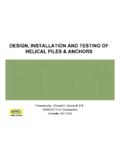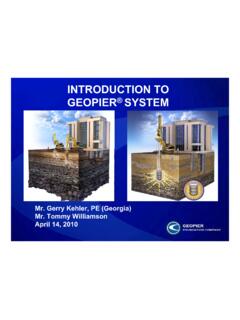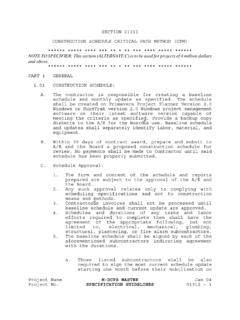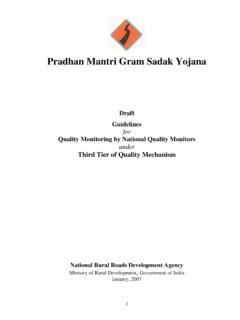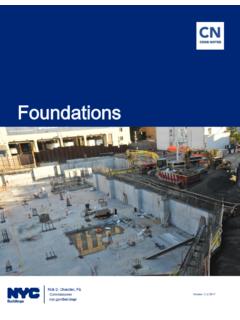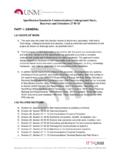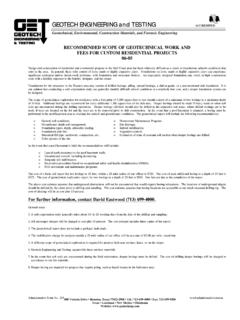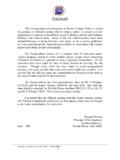Transcription of Guidelines for Inground Swimming Pools-12Sep07
1 RECOMMENDED Guidelines FOR DESIGN AND CONSTRUCTION OF Inground Swimming POOLS IN HOUSTON, TEXAS PRESENTED AT THE FOUNDATION PERFORMANCE ASSOCIATION SEPTEMBER 12, 2007 MEETING BY DAVID A. EASTWOOD, GEOTECH ENGINEERING AND TESTING SEPTEMBER 2007 GEOTECH ENGINEERING AND TESTING TABLE OF CONTENTS PAGE 1 1 Site Conditions .. 1 Geotechnical Considerations .. 1 Field Exploration.. 1 Laboratory Testing .. 2 Site Conditions .. 2 Soil 2 Groundwater Level..2 General Soils Conditions .. 2 Geotechnical Design Information .. 3 Structural Consideration in Pool Design .. 4 Pool Structure 5 General .. 5 Subsoil Removal and Replacement with Select Structural 5 Vertical Moisture Barrier ..5 Pool Structure on Void Spaces .. 6 Chemical 6 Helical Piles.
2 6 Structural 7 Pool Bottom .. 7 Pool 8 Buoyancy .. 8 Flat Work .. 9 Effect of Trees/Planter Areas on Pools .. 9 Existing 9 New Trees .. 9 Planter Areas .. 9 Construction Pool Groundwater Fill Characteristics ..10 Select Structural Fill..10 Structural Fill ..10 General Fill ..10 Drilled Footings Installations ..10 Helical Pile GEOTECH ENGINEERING AND TESTING Surface Water Quality Control ..11 Drilled Footing Steel Observations ..11 Gunite ..11 Site Qualifications of the Geotechnical Firm ..13 Acknowledgements ..13 References ..13 GEOTECH ENGINEERING AND TESTING GEOTECH ENGINEERING and TESTING ACCREDITED Geotechnical, Environmental, Construction Materials, and Forensic Engineering RECOMMENDED Guidelines FOR DESIGN AND CONSTRUCTION OF Inground Swimming POOLS IN HOUSTON, TEXAS PRESENTED AT THE FOUNDATION PERFORMANCE ASSOCIATION SEPTEMBER 12, 2007 MEETING By David A.
3 Eastwood, (1) Introduction Many Inground Swimming pools are built in the Houston area. The author has observed many of these pools experiencing movements, cracking, etc. The purpose of this document is to highlight prudent practices and Guidelines for design and construction of pools to protect the public and pool contractors against a faulty pool design and construction. Pool design and construction should always consider the effects of subsoil, groundwater, structural considerations, drainage, trees, slopes, etc. Design General. A design of the pool should consider the geotechnical considerations, groundwater, slopes, environmental conditions such as trees and drainage. In addition, structural issues should also be considered in the design of any pool.
4 Pools should be designed in general accordance with the latest version of American National Standard for Residential Inground Swimming Pools (Ref. 1). The 2003 version of this document states that the structural design and materials used shall be in accordance with generally accepted structural engineering practices and methods. Site Conditions. Site conditions are crucial in designing a pool. Typically, a site which is flat with no slopes provides the most favorable site condition. However, sites on slopes, next to ravines, provide the most arduous design considerations. Trees also affect the performance of pool structures. Pools that are to be placed near slopes should consider the effects of slope geometry as well as erosion considerations. A geotechnical study should be conducted to address the issue of slope stability and erosion for pools designed and constructed on slopes steeper than 5(h):1 (v).
5 Geotechnical Considerations Field Exploration. A geotechnical exploration and report by a geotechnical engineer licensed in the State of Texas should be conducted for design of any pool. The geotechnical exploration will involve drilling soil borings at the location of where the pool is going to be constructed. In general, the depth of the soil borings should be twice the depth of the pool with a minimum depth of 20-ft. A minimum of two borings should be conducted for pools of less than 3000 sq. ft. Additional borings should be performed if pools are larger than 3000 sq. ft. A minimum of one boring should be conducted for any additional 1500 sq. ft. of pool area. The borings should be sampled continuously from the surface to a minimum depth of 10-ft and at five-ft intervals, thereafter.
6 All cohesive soils should be sampled in general accordance with ASTM D1587. The cohesionless soils should be sampled in accordance with ASTM D1586. Root fibers should be obtained in all borings to help evaluate the active zone. (1) Principal Engineer, Geotech Engineering and Testing, 800 Victoria Drive, Houston, Texas 77022, Tel.: 713-699-4000, e-mail: 800 Victoria Drive Houston, Texas 77022-2908 Tel.: 713-699-4000 Fax: 713-699-9200 Texas Louisiana New Mexico Oklahoma Website: 2 GEOTECH ENGINEERING AND TESTING Laboratory Testing. Classification and strength tests should be conducted to develop a soils stratigraphy of the subsoil conditions. In general, all laboratory testing should be conducted in accordance with American Society for Testing Materials Standards (ASTM).
7 The tests should include classification and strength tests. All subsoils should be classified in accordance with the unified soil classification system. Site Conditions. The geotechnical engineer representative should observe and photograph the site conditions during the field exploration. He should address the site conditions if there are trees on the site in close proximity to the pool. He should address slopes, ravines, ponds, and other unusual site features that may result in adverse pool performance. Photograph(s) of the project site should be included in the geotechnical report. Soil Stratigraphy. The geotechnical engineer should address the subsoil conditions at the project site. He should define a soils stratigraphy all the way to the bottom of the borings.
8 The soils stratigraphy should also define how expansive the subsoils are as well as their strength and moisture contents. Groundwater Level. The borings should be drilled dry to evaluate the presence of perched water to free water conditions. The level where free water is encountered in open boreholes during field exploration should be noted on the boring logs. Fluctuations in groundwater level generally occur as a function of seasonal variation, temperature, groundwater removal, and future activities near the project site. Therefore, the pool contractor should verify groundwater depth prior to start of construction on any new pool. This is because the time that a geotechnical study was conducted may be different than the time the pool is constructed.
9 A pool designer should assume groundwater level at the surface for design of the pool system. The groundwater levels in the Gulf Coast area vary significantly. The groundwater depth in the Houston area generally ranges from 0- to 25-ft . The groundwater measurements are usually evaluated by the use of a tape measure and weight at the end of the tape at the completion of drilling and sampling. Some of the groundwater problem areas in Houston include Southside Place, parts of Sugar Land, West University, etc. One should not confuse the perched water table with the groundwater table. A perched water table occurs when insufficient drainage exists in the areas with a surficial sand or silt layer, about two- to four-ft. thick, underlain by impermeable fat and lean clays. During the wet season, water can pond on the clays and create a perched water table.
10 The surficial sands/silts become extremely soft, wet and may lose their load carrying capacity. General Soils Conditions. Variable soil conditions occur in the Houston area. These soils are different in texture, plasticity, compressibility, and strength. It is very important that a pool structure be designed for subsoil conditions that exist at the specific site in order to reduce potential pool distress. Expansive soils can cause major damage to pool structures in the Gulf Coast area. Expansive soils are classified to be soils with liquid limit greater than 40 and plasticity index (PI) of greater than 20. Details of general subsoil conditions at various parts of the Houston area are described below. Significant variations from these descriptions can occur. The general soil conditions are as follows: 3 GEOTECH ENGINEERING AND TESTING Location Soil Conditions Northwest and Northeast Houston, including Generally sandy surficial soils occur in these areas.
